
-Dave
The Chirpy
Greetings All- Find below a photo from the book The Arts and Crafts of
Turkestan by Johannes Kalter, described as "Wife of a Tekke Khan,before 1890".
Khalter goes on to say that urban denizens of the female persuasion wear a
version, sans embroidery, which flows to the heels and accompanied by a veil.

-Dave
Hi Dave
Kalter's little book is a great source of photos of Central
Asian artifacts taken on location. It's easy to see on this one why the fringe
on chyrpy are often replaced - that is almost the only part of the garment that
is subject to abrasion when it's worn.
Too bad the book doesn't include a
photo taken from behind, to show the false sleeves, the pattern and the density
of the embroidery. If this is, in fact, a khan's wife, we might presume that her
festive clothing is at what the Tekke considered to be the high end of such
things.
Thanks,
Steve Price
Clutter Factor
Hi Steve,
In your essay you were asking about the density of the
embroidery as an indicator of age. I have only seen photos of antique pieces but
I've seen several of what I consider "older" chyrpys and I note the
following:
1) The older pieces had much denser coverage in the areas
covered with embroidery.
2) The level of detail, REALLY fine work,
is higher in the older pieces.
I have seen older chyrpys with substantial
areas of open space, but the detail work in the embroidered area was amazing.
The first three images are of a "newer" piece, probably no older than
30-40 years (and maybe a lot newer, who knows ?). The workmanship is good but
relatively coarse. The last piece is probably a little older (who knows how old
? ...not me, but still probably mid-20th century). You can see the difference in
the detail work.
Janet Harvey (Traditional Textiles of Central
Asia) notes that the older pieces had linings that were decorated with block
print designs (sometimes using potatos, say my friends), instead of the machine
made Russian cloth we generally see on new pieces.
The problem is that 1)
Russian cloth has been available for a LONG time and 2) modern embroiderers are
perfectly capable of doing extremely detailed work. So it doesn't look like
there are a lot of hard rules one can use in the age determination
process.
I'll put up some images of a piece that is a little older
shortly.
Regards,
Chuck Wagner



__________________
Chuck
Wagner
Hi Dave & Steve,
Here's a piece that is interesting. It's unusual
in that the designs in the field are rather similar to those in Tekke guls on
piled pieces, a feature not usually seen on chyrpys.
I use the term
chyrpy loosely in this case because this has the heft, and look, of a mans
garment. It's been my understanding that chyrpys are usually worn on top of a
jeweled headpiece in ceremonial or formal settings where traditional dress is
appropriate, as opposed to being worn as mantles over the shoulders. I
differentiate the two by the geometry of the vestigial sleeves: those on chyrpys
taper to (sometimes) less than 2 inches across at the tip, whereas a mantle
would have vestigial sleeves as wide as a normal sleeve. So, I guess I would
call this a mantle rather than a chyrpy.
Either way, I like it a lot:
Attractive dark green field and some really good embroidery work. Nicely
finished sleeve cuffs as well.
Regards,
Chuck Wagner



__________________
Chuck
Wagner
Professional embroiderers?
Steve,
Is there any speculation that many of these embroideries were
done professionally? The patterns, as has been pointed out, are usually quite
unlike the rug patterns. And we know that many of the rugs and trappings were
family made. But would the embroideries be so specialized that they were made
for sale by professional embroiderers?
One might think that the ground cloth
was not made in a yurt, certainly not on a rug loom. Why then would the
embroidery not be done professionally?
I have read about suzani patterns
being drawn by professionals onto the cloth and then the stitching was done by
the buyer.
Are there any signs of a similar technique on chirpy's or other
garments?
Like a label sewn in to the back of a chirpy, "Chirpy's "R" Us"? Or
signs of patterns having been put on the garment before embroidering?
I do
not happen to have one in my closet, so I am unable to check.
Patrick
Weiler
Hi Pat
I'm sure that the silk ground cloth that the embroidery was
done on is not tribal. It must have been bought at urban centers.
As for
whether the designs were inked onto the ground cloth before embroidering, it
doesn't seem like it would be practical on the dark color cloths, and that's
what most chyrpy are. I've not seen traces of ink markings on the few yellow or
white ones that I've handled, although I wasn't really looking for them and
might have just not noticed.
Regards
Steve Price
19 th Century Chyrpy?
All- The Following images are from Khalter as described above and labeled as
possibly late 19th century.
"Women's mantles which are pulled over the
head and serve as veils. Cotton with silk embroidery. The mantles form part of
the costume of married women. The mantles of young women have a black ground,of
middle aged women a yellow ground and women over sixty a white ground. The rear
side shows the dummy sleves which are typical of Turkestan women's costume. Teke
Turkmen."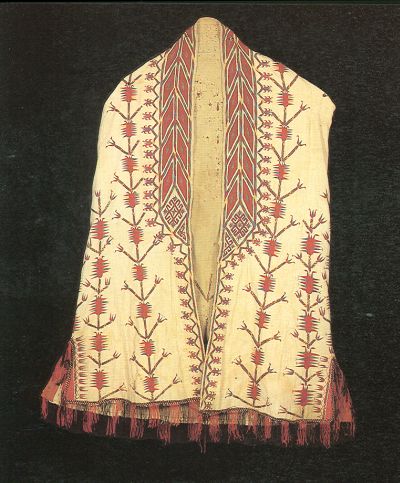
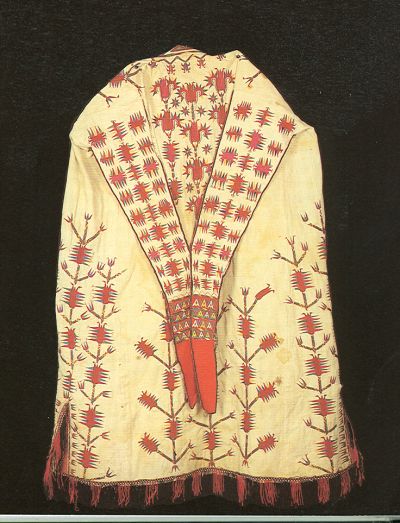
The following image is described as "Teke woman's mantle. A
mixture of cotton and silk, with partially fire gilded silver ornaments set with
cornelians. Lining of Russian printed cotton. End of 19th century?"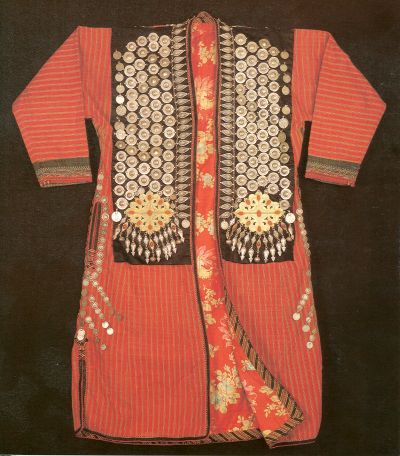
More From Kalter
All- More on the Chirpy- and Others
Then house dress of Turkestan
women basically consists of trousers and a loose ankle length dress frastened at
the neck with a stud among the Yamout (and also among the Tekke women) but
otherwise with ribbons. The clothing consists of silk or semi-silk fabrics. The
favorite color for Turkmen clothing is red with a yellow stripe, but violet is
frequently used too. The front of the Turkmen dress may be set from the shoulder
to waist with as many as a hundred silver pendants the size of five penny
pieces. The ends of trouser legs of Turkmrn women may be completely covered with
a wide piece of embroidery, especially typical of the Ersari of Afghanistan.
Yomut embroidery on dresses ande trousers does not cover the whole background
and has much less striking pattern.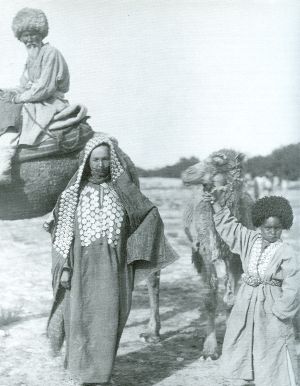
Tekke family before
1890.
Trouser turnups from N. Afghanistan. Lower right mens, rest
female.Removed when clothing worn, attached to new.
The
favorite material for the shirts and trousers of urban women was ikat. Ikat
clothes have become virtually the national costume of Uzbekistan, but are
frequently worn by Turkmen women as well. Instead of ikat clothes, wealthy women
wore dresses of imported brocade or Chinese damask; poorer women wore
monocromatic cottom dresses. Dresses made of russian printed material with large
flower patterns were and are worn by all Turkestan women.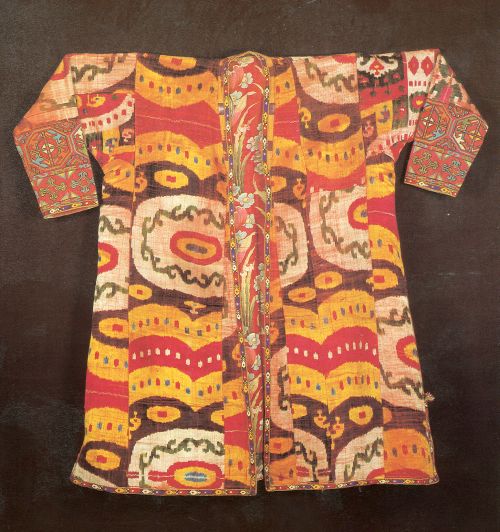
Velvet ikat coat of Khivan
dignitary with embroidered cuffs and printed Russian cotton lining End 19th
cent..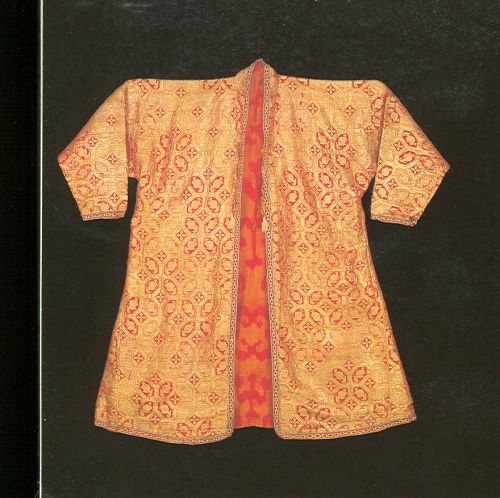
Coat of dignitary, Russian gold brocade with silk ikat lining.
End of 19 cent..
We have also mentioned the corresponding item of
Turkmen clothing, the chyrpy of Teke women covering the head and reaching to the
hips. Dark blue chyrpys are usually the most lavishly embroidered, white ones,
the most sparsely. Favorite motifs are flowering shrubs in the form of trees of
life. Individual flower stalks or shrubs -more rarely- rhomboid lattices with a
floral or palm leaf-like filling also occur. Among the floral motifs tulips and
compositae shapes predominate. In striking contrast to the otherwise floral
ornamentation is the richly varied decor on the tapering ends of dummy sleeves
and on the front yoke, like a shawl collar, which often terminates in a rhomboid
motif enclosed by rams horns.
In other Turkmen groups the chyrpy was
replaced by a headcloth, generally red, which can, but does not have to, be
pulled over a foundation of leather, plaited plant fibers, felt, or
recently,board, or a high cap.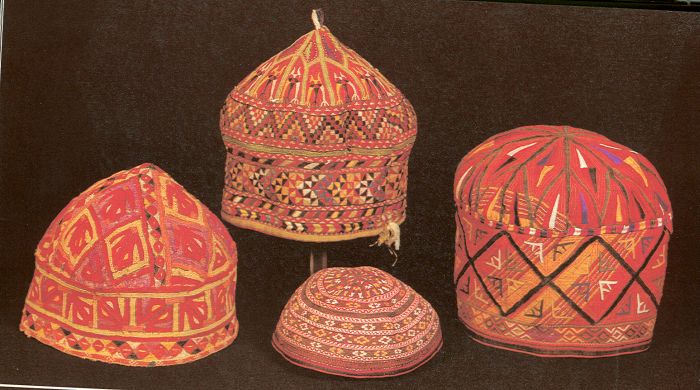
Three tall caps from girls of N.
Afghan groups. Small boys cap of the Yamout.
The unmarried girl,
on the other hand, wears only a round cap, which may be topped by a domed shaped
silver element and is usually set with smaller silver components stamped in
matrices. Similar caps form parts of the dress of rural Uzbek
girls.
Caps of marrigable girls of N Afghanistan. Style of embroidery
of left cap is N. Afghan Turkmen,crown element is of Tekke style and plait of
Ersari. Right, both embroidery and elements of Lakai Uzbek, fire guilded parts
indicative of Khiva.
Turkmen women sometimes wore a coat over
their dress. Our example (previous post) is from the Teke. It is lavishly
adorned with jewellery and is closed with the typical rhomboid plates equipped
with hooks and eyes. The Yomut prefered wine-red or green velvet coats. The
museum possesses an Ersari coat of violet silk.
- Dave
A Puzzler
Hi Dave, et all,
So, speaking of violet silk coats:
I'm unsure of the origin
of this piece. The dealer, an old Afghani,
says it's a Turkoman coat (and I
suppose it could very well be
Ersari). I've seen Uzbek embroideries with this
look, but the
suzani stitches that I've seen are different from
this:
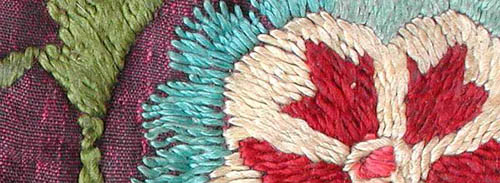
I'd like to know if anyone else has seen Turkoman work like
this.
Regards,
Chuck Wagner
__________________
Chuck
Wagner
Urban Manufacture
Patrick and All- still another quote from Kalter, just a short blurb from a
discussion of embroidery techniques:
Section of veiling used by
Turkmen,cotton. The decor of the fabric, made in an urban manufactory, is
pierced and sewn.
- Dave
Uzbek and Ikat
All- I found this image of a Uzbek woman and labeled as circa 1907-1915.
Notice the simularities to the Turkmen.
This image was labeled simply, Fabric
Merchant,1911.
Hi Dave
What is the source of those photos? I doubt that they were
taken at the times indicated - color photos of that quality just couldn't be
done around 1905-1915.
Regards
Steve Price
Dear Steve,
the colors have been computer added. Somebody has figured
out from the infromation on the original black and white photos what the colors
must have been . . . from the image of the Uzbeck girl by the yurt the colors
while far from perfect do, is this case at least, give a good impression of what
they must have been.
Somebody has written about this previously on the
site if i am not mistaken.
Regards
Richard
Colorization?
Steve and All- I had assumed that this was some form of colorization process. I pulled up this list of images with a Google image search of the word "Turkmen", at http://www.pratyeka.org./ The colors don't seem right I realize, and while I know that some early experimentation was done with color- early films such as the Phanton of the Opera contained painstakingly hand painted sequences- this seems to me more at electronically fiddled. But I really don't know- Dave
Dear All,
If I remember well, those photos were already presented in
John’s salon on Engsi.
Anyway, I bookmarked them. The source is the Library
of Congress, PROKUDIN-GORSKII Collection.
http://lcweb2.loc.gov/pp/prokhtml/prokabt.html
And,
yes, those were indeed color photos, but what we see is a digital
reconstruction. See link:
http://lcweb2.loc.gov/pp/prokhtml/prokcolor.html
Regards,
Filiberto